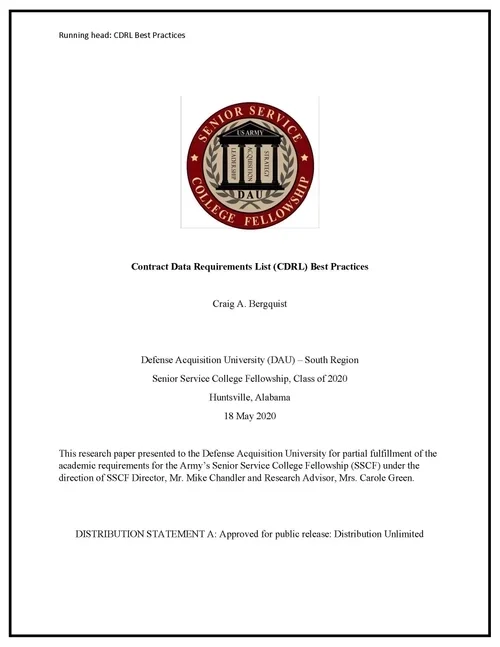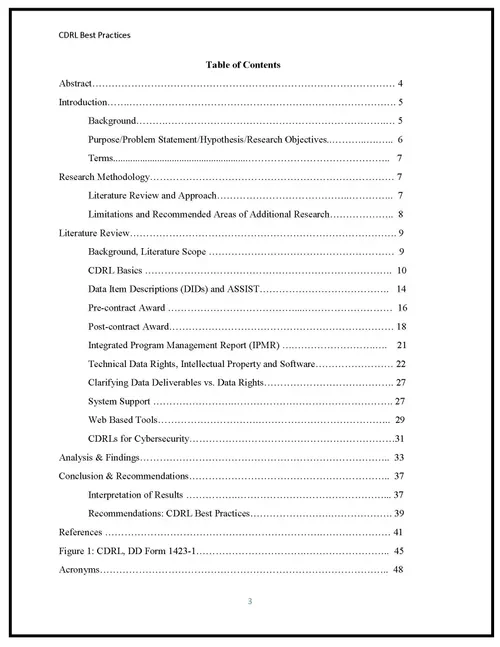Contract Data Requirements List CDRL Best Practices
In a recent CMsights post we presented the case that Contract Data Deliverables Management, and in particular managing the processes surrounding Contract Data Requirements Lists (CDRL), is no longer a simple spreadsheet exercise for data clerks nor a mundane scheduling task for project managers.
There are numerous contributing factors which have caused the process of managing CDRLs (and SDRLs) to become not only a more arduous task, but at the same time increasingly important to the bottom-line performance of a DoD program or profitability of a supplier’s contract.
As we discussed, a primary factor is that longer-spanning Aerospace & Defense contract awards for inherently more complex and costly programs over their lifecycles are experiencing a greater number of requirements revisions, SOW addendums, design changes, milestone submissions, Work Breakdown Structure (WBS) modifications, Data Item Description (DID) additions, accounting audits, and progress payment hurdles. And each additional change and iteration creates more opportunities for errors, misinterpretations, disputes, and reworks that lead to delayed payments.
Thankfully, as the handling of CDRLs has become more demanding to orchestrate, best practices (BP) have emerged over recent years from a number of contractors, government agencies, industry associations, and CDRL software tool providers like CMstat.
CDRL Best Practices Example from DAU
A prime example is the Defense Acquisition University (DAU) publication “Contract Data Requirements List (CDRL) Best Practices” prepared by Craig Bergquist under the guidance of Mike Chandler and Carole Green. This 2020 DAU paper provides a comprehensive overview on CDRLs, especially for new program or supplier contract managers. The paper, approved for public release, is available for downloading here as well as directly from the DAU website.
In the paper, the author summarizes five important best practices (BP). While most are from the perspective of the government Program Office (PO), best practices for the contractor or supplier are equally important to consider by reading the entire paper.
“BP 1: Require PO managers and key leaders to take CDRL and contracts related familiarity training (on-line or classroom) once assigned to a program that requires contractor data to execute a program. Training should include linking CDRLs with contract elements, to include the SOO, RFP, SOW, contract incentives, technical data and testing.
BP 2: PO managers should initiate frequent dialogues with contractor counterparts concerning the delivery of CDRL data. While CDRLs define contract deliverables, misinterpretations are possible and subjective judgement may be the best approach for resolution. Regardless of the level of technical knowledge on a contract, basic program manager and contract officer communication with contractor counterparts is essential for program success.
BP 3: Contract for the right CDRLs. Literature identified the need to justify each CDRL on contract. While some financial CDRLs are mandated, many in the technical and logistics areas are optional. Program managers should know CDRL costs, intended purposes and evaluate outcomes to defer or not acquire.
BP 4: PO managers should work with contractor counterparts to agree on the CDRL submission, review and approval process. The process, together with associated due dates and frequencies should be shared with all program stakeholders. Techniques include color-coding CDRL due dates and automatic email reminders to keep up with CDRL schedules. Complex CDRLs often need their own schedule with knowledge points and milestones to manage status. IPTs are useful for this purpose.
BP 5: PO’s and contractors should seek to use GOTS or COTS web-based tools to aid in managing CDRLs. DoD agencies and the services have generated useful tools to simplify CDRL processing.”
The last BP on the use of web-based CDRL tools has been adopted to varying degrees by A&D contractors as commercial software products have emerged and evolved over the years. As example, starting in 1995, CMstat offered the first commercial-off-the-shelf (COTS) client-server based Data Management (DM) tool for CDRLs which became web-based with the release of the EPOCH DM software product in 2013 which fully supports the EIA-859 Data Management Standard.
Yet, despite the availability of CDRL management tools like EPOCH DM, many suppliers remain mired in a labyrinth of emails with spreadsheets, fragile custom code extensions to existing PDM or PM software, or legacy utilities written by SME who may have long since retired.
In the consulting services and training classes that CMstat provides to its EPOCH DM customers, we reference another top-level best practice associated with CDRL management strategies and tools.
“The process of assessing needs and defining requirements, then evaluating, selecting, and implementing a CDRL tool should be performed in collaboration with all process stakeholders across the enterprise and not just mandated from the PO or the IT organization.”
Challenges to Implementing CDRL Best Practices and Software Tools
This BP addresses one of the principal obstacles to implementing a CDRL management strategy: at both the contractor or supplier level the benefits derived from doing so, as well as the costs of failing to do so, is typically experienced by others who will not be the primary users of any CDRL software tool. This is similar to other PLM, PDM, and CM software tools where financial rewards and risk avoidance often accrue to departments who are not the creators or users of product data or deliverables data.
In the ideal world and as in BP 1 above, the program offices within both the government agency and contractor would indeed take the lead with specifying the data handling processes and then defining data deliverables required for each contract. However, In the real world the responsibility, authority, and accountability is not always so clear and crisp, especially across deep multiple-tier supply chains that frequently span international borders.
The reason is that the process of CDRL data collection, validation, and delivery – which might appear to others as simple – involves many steps that go unnoticed until they go wrong. These tasks include the acts of: scheduling, searching, collecting, tracking, authenticating, revising, reporting, approving, submitting, reconciling, rejecting, securing and archiving all the data deliverables and supporting documentation for a contract.
This is why the best Data Managers are far more than the data clerks of yesteryear. Instead, they are more like masterful detectives hunting down clues as to where suspect data is hiding out across numerous organizations which can include:
Project and Project Management
Finance & Contracts
Design Engineering & Engineering Services
IT & Data Management
Manufacturing & Supply Chain
Documentation and Tech Pubs
Procurement & Logistics
Quality & Test
Delivery & Service
Legal, Security & Compliance
It is no surprise to suppliers that managing the soft data deliverables associated with a contract can generate as much anxiety at times as delivery of the actual hard product. And no doubt it should since in performance-based contracting the financial payments, penalties, and bonuses are as dependent on the supporting data packages being delivered as accurately, completely, and timely as is the contracted product.
As a result, it is not uncommon that the burden of actually performing much of the work – and taking blame when things go missing or wrong – falls mostly to others outside of the PO. Understandably, participants outside of the PO have just as much or more at stake in seeing CDRL processes well defined, standardized, automated, secured, and optimized with defendable performance metrics.
This is why the selection, implementation, utilization, and leveraging of CDRL software tools should not be undertaken in an isolated fashion or postponed and then rushed once the contract has been awarded with the project schedule already running. Planning for the effective management of contract data deliverables before the contract is awarded as part of the proposal response and bidding process is a best practice.
Improved CDRL Data Management Can Maximize Contract Revenues
For these contractors, improving the management of data deliverables through best practices can become a source of revenue enhancement to be invested in, instead of a cost center to be avoided.
In future CMstat posts on Contract Deliverables Data Management, we will share other best practices we have witnessed our customers learn both the easy and hard way. Until then, we recommend exploring the following resources from CMstat and others includeing the DAU:
For the latest news, follow CMstat on LinkedIn and register to receive our CMsights posts.
Receive CMsights
Subscribe to CMsights News for the latest updates from CMstat on Configuration Management, Data Management, EPOCH CM, and EPOCH DM.
Request a Demo
See how EPOCH CM and EPOCH DM support industry standards and best practices in Configuration Management and Data Management.



